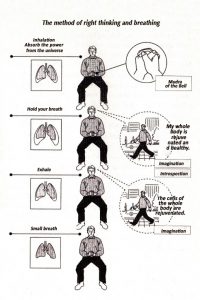When a human being draws breath for the first time at birth, then he or she has physically entered this life anew and with it begins a cycle of inhaling and exhaling, which only ends with us inhaling one last time and saying goodbye to life again with the last exhale. An adult breathes about 16 to 18 times per minute, i.e. 1,080 breaths per hour, 25,920 breaths per day and about 9,331,200 breaths per year. With an average life expectancy of 76 years, a man takes 709,171,200 breaths in his lifetime, a woman 755,827,200 (life expectancy 81 years).
While we can go for several weeks without solid food and a few days without liquid, only a few minutes without oxygen lead to death, after only 20 seconds there is no more electrical brain activity.
The breath, however, provides us with much more than “just” oxygen. In all ancient cultures there was the knowledge that the (healing) energy or life force of the universe, which exists in all living things and constantly flows around and through our body, is also present in the breath. The Chinese call this force “Chi”, in Sanskrit the term “Pranha” was commonly used. Movement exercises like in Tai Chi, Qi Gong or Yoga are based on this knowledge of the power of the breath. Zen monks have also practiced the art of deep abdominal breathing for thousands of years, which helps to calm anger, irritation and confusion.
Abdominal breathing, which babies still practice quite naturally, has been unlearned by many people nowadays. Most of us only breathe superficially in the chest, especially in situations of stress and anxiety. In the long run this is very harmful for our body, as our cells are not supplied with the necessary vital energy. Cells that do not receive enough oxygen “starve” to a certain extent, which is a typical characteristic of cancer cells.
The Japanese physician Dr. Nobuo Shioya developed a particularly efficient and easy to perform breathing exercise, which we would like to introduce and recommend to you below (see illustration). The exercise places particular emphasis on practicing not only right breathing but also right thinking. In practice, this means that in addition to the breathing technique, you also use the power of imagination to absorb the vital energy together with the air you breathe, thus further enhancing the effect of the exercise. By the way, Dr. Shioya lived to be 105 years …
 1. Body Posture and Mudra of the Bell
1. Body Posture and Mudra of the Bell
Sit upright and relaxed with your back straight so that the air can fill your entire lungs. You can sit on a chair (do not lean your back against the chair or place your forearms on the armrests) or sit on the floor in a meditation posture or cross-legged. If you want to sit on the floor, you can, for example, fold a flat seat cushion in the middle and place it under your bottom or use a meditation cushion. (If you are unable to sit upright due to illness or weakness, you can practice lying on your back. To do this, place both arms stretched out to the side of the body with the palms of your hands facing down).
Now relax your shoulders and hold your arms to the side of your body so that they form a right angle at the elbows. Then place the palms of your hands together in front of your navel, as if you wanted to gently embrace a small ball. Your active hand is on top, i.e. the right hand for right-handed people and the left hand for left-handed people. The thumbs are on top of each other and the four fingers are closed together to form a cavity. This is called the Mudra of the Bell.
a. Breathe in:
Breathe in through the nose calmly and silently until the lungs are completely filled with air, then push the inhaled air down energetically to the lower abdomen. This will naturally lower the diaphragm and fill the lungs to the base.
b. Hold your breath:
Put strength in the centre of the body by tensing the lower abdomen and firmly closing the anus, and hold your breath for a few seconds, but only as long as it does not become uncomfortable (ten seconds maximum).
c. Exhale:
Exhale silently and as completely as possible through your nose. As you do so, slowly release the tension in the lower abdomen and anus, allowing the abdominal wall to sink back in. The exhalation should take about twice as long as the inhalation.
d. Small breath:
Now breathe normally once or twice to regulate breathing.
Repeat this breathing cycle twenty-five times daily, in one go or divided into several small cycles. A special feature of this breathing technique is that you use the power of positive thoughts, thinking intensively or asking for this or that to happen or to be in a certain state. The imagination is of course not limited to health, but can be applied to all areas of life. To bring the imagination into harmony with the breath and to form a healthy body, one proceeds as follows:
a. As you inhale, imagine: “In the centre of my body, the infinite power of the universe gathers. It is filling my entire body.”
b. While holding your breath, imagine: “My whole body is perfectly healthy. My… (name your disease) is healed.”
c. As you exhale, imagine: “All waste products and toxins in my body were completely eliminated when I exhaled. My entire body is purified. The cells of the entire body have rejuvenated.”
For each disease you can repeat this cycle five times; that is, if you suffer from five diseases, you will have twenty-five repetitions. People with fewer ailments repeat the name of the disease they wish to cure in the first place as often as they wish. And those who have no problems at all repeat twenty-five times: “The cells of my whole body are perfectly healthy.”
At the beginning, do not practice for more than ten minutes at a time. You may do no harm to yourself by prolonged exercise, but because certain muscles are used intensively, untrained people may experience muscle pain the next morning after very long practice. That is why, in the beginning, you should not practice abdominal breathing excessively. In any case, avoid going so far that you end up thinking “This is really hard!” or “This is much too strenuous!” In this case, negative ideas will be associated with the practice, which can have the opposite effect to what you actually want to achieve.
We now wish you good results and a long breath!
Note: This breathing exercise as well as the illustration for it are taken from the book “Die Kraft strahlender Gesundheit: Neue Vitalität für Millionen Körperzellen” by Dr. Nobuo Shioya, published in German by Goldmann Verlag.








